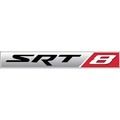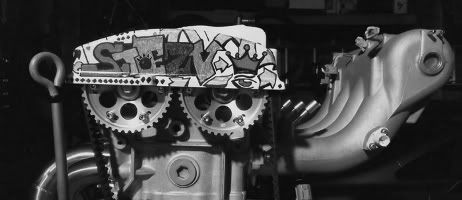Post by prudz on Feb 14, 2013 19:57:41 GMT -5
In the last couple days Bossrex has been trying to figure out what tires will work best with his setup. After the discussion of many tires, an argument between myself and a parts jockey at my work I figured it would be beneficial to the members of the forum to have some information on how to buy a tire that is right for you and your cars setup. If you feel you have other information that is missed please add to the thread and i'll update my original post as more information comes in.
UTQG, What is it?
UTQG stands for Uniform Tire Quality Grading. The National Highway Traffic Safety Administration (NHTSA) established the Uniform Tire Quality Grading Standards. The UTQG rating is made up of three components: Tread wear, traction, and temperature.
Tread wear
The tread wear grade is a comparative rating based on the wear rate of the tire when tested under controlled conditions on a specified government test track. A tire graded 200 would last twice as long on the government test course under specified test conditions as one graded 100. These tread wear grades are no guarantee of actual tire mileage; differences in driving habits, service practices, climate, and road characteristics will affect a tire's longevity.
Traction
Traction grades, from highest to lowest, are AA, A, B and C. They represent the tire's ability to stop on wet pavement as measured under controlled conditions on specified government test surfaces of asphalt and concrete. The testing does not take into account cornering, hydroplaning or acceleration.
The UTQGS traction test procedure measures a tire’s coefficient of friction when it is tested on wet asphalt and concrete surfaces. The test tire is installed on an instrumented axle of a traction trailer, which is towed by a truck at 40 miles per hour (mph) over wet asphalt and concrete surfaces. The tow truck is equipped with an on-board water supply system that sprays water in front of the test tire. The brakes, from the test tire only, are momentarily locked, and sensors on the axle measure the longitudinal and vertical forces as it slides in a straight line. The coefficient of friction for the pair, test tire and surface, is then determined as the ratio of the longitudinal and vertical forces.
The UTQGS traction rating procedure specifies that the traction coefficients for asphalt and for concrete are to be calculated using the locked-wheel traction coefficient on the tire, or sliding coefficient of friction. More specifically, upon application of the brakes, the tire is subjected to shear between the wheel and the road surface, and deforms towards the rear of the vehicle. This generates a traction force to oppose the motion of the vehicle. As braking torque increases, the tire deforms more and tread elements near the rear of the contact patch with the road begin to slip rather than grip. The coefficient of friction rapidly reaches a maximum value at about 10-20 percent slip, and then declines as the longitudinal slip values increase to 100 percent, which represents a fully locked tire. The maximum coefficient of friction in the 0-100 percent slip range is termed “peak” coefficient of friction, and the lower coefficient value for the fully locked tire is termed “slide” coefficient of friction.
Temperature
The temperature grades, from highest to lowest, are A, B and C. These represent the tire's resistance to the generation of heat.
Now that we know the basics we can look at some examples. I found that the site www.1010tires.com is one of the best sites to find the information on most tires you would want.
Tire speed rating is a system where the maximum safe traveling speed of a properly inflated tire is determined after that model tire has been tested. Each letter in the rating system indicates a specific maximum safe speed, with the most common rating being 'H', which translates to 130 MPH (210 kph). While there is a speed rating assigned to most every letter of the alphabet, car and truck tires generally fall between the letters Q and Z. Specific designations are listed below, followed by maximum speeds in MPH and kph.
Tire speed rating chart

As may seem obvious when looking at the above numbers, this is a system originally set up in Europe for speeds in kilometers per hour. With automobiles commonly traveling at triple-digit speeds on roads like the German Autobahn, the government there needed to devise a system to ensure that tires fitted on high-powered cars were capable of withstanding these types of speeds.
A higher tire speed rating equates to better heat resistance, increased stability and traction and enhanced braking, acceleration and cornering. It also typically means higher cost and a shorter life expectancy. It is not recommended to install tires of a lower tire speed rating, although the family sedan that came with 'H' rated tires will probably never see 130 MPH, under-inflated or overloaded tires may require the extra cushion of safety and stability.
UTQG, What is it?
UTQG stands for Uniform Tire Quality Grading. The National Highway Traffic Safety Administration (NHTSA) established the Uniform Tire Quality Grading Standards. The UTQG rating is made up of three components: Tread wear, traction, and temperature.
Tread wear
The tread wear grade is a comparative rating based on the wear rate of the tire when tested under controlled conditions on a specified government test track. A tire graded 200 would last twice as long on the government test course under specified test conditions as one graded 100. These tread wear grades are no guarantee of actual tire mileage; differences in driving habits, service practices, climate, and road characteristics will affect a tire's longevity.
Traction
Traction grades, from highest to lowest, are AA, A, B and C. They represent the tire's ability to stop on wet pavement as measured under controlled conditions on specified government test surfaces of asphalt and concrete. The testing does not take into account cornering, hydroplaning or acceleration.
The UTQGS traction test procedure measures a tire’s coefficient of friction when it is tested on wet asphalt and concrete surfaces. The test tire is installed on an instrumented axle of a traction trailer, which is towed by a truck at 40 miles per hour (mph) over wet asphalt and concrete surfaces. The tow truck is equipped with an on-board water supply system that sprays water in front of the test tire. The brakes, from the test tire only, are momentarily locked, and sensors on the axle measure the longitudinal and vertical forces as it slides in a straight line. The coefficient of friction for the pair, test tire and surface, is then determined as the ratio of the longitudinal and vertical forces.
The UTQGS traction rating procedure specifies that the traction coefficients for asphalt and for concrete are to be calculated using the locked-wheel traction coefficient on the tire, or sliding coefficient of friction. More specifically, upon application of the brakes, the tire is subjected to shear between the wheel and the road surface, and deforms towards the rear of the vehicle. This generates a traction force to oppose the motion of the vehicle. As braking torque increases, the tire deforms more and tread elements near the rear of the contact patch with the road begin to slip rather than grip. The coefficient of friction rapidly reaches a maximum value at about 10-20 percent slip, and then declines as the longitudinal slip values increase to 100 percent, which represents a fully locked tire. The maximum coefficient of friction in the 0-100 percent slip range is termed “peak” coefficient of friction, and the lower coefficient value for the fully locked tire is termed “slide” coefficient of friction.
Temperature
The temperature grades, from highest to lowest, are A, B and C. These represent the tire's resistance to the generation of heat.
Now that we know the basics we can look at some examples. I found that the site www.1010tires.com is one of the best sites to find the information on most tires you would want.
Tire speed rating is a system where the maximum safe traveling speed of a properly inflated tire is determined after that model tire has been tested. Each letter in the rating system indicates a specific maximum safe speed, with the most common rating being 'H', which translates to 130 MPH (210 kph). While there is a speed rating assigned to most every letter of the alphabet, car and truck tires generally fall between the letters Q and Z. Specific designations are listed below, followed by maximum speeds in MPH and kph.
Tire speed rating chart

As may seem obvious when looking at the above numbers, this is a system originally set up in Europe for speeds in kilometers per hour. With automobiles commonly traveling at triple-digit speeds on roads like the German Autobahn, the government there needed to devise a system to ensure that tires fitted on high-powered cars were capable of withstanding these types of speeds.
A higher tire speed rating equates to better heat resistance, increased stability and traction and enhanced braking, acceleration and cornering. It also typically means higher cost and a shorter life expectancy. It is not recommended to install tires of a lower tire speed rating, although the family sedan that came with 'H' rated tires will probably never see 130 MPH, under-inflated or overloaded tires may require the extra cushion of safety and stability.








